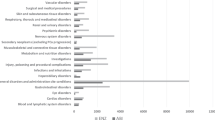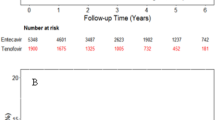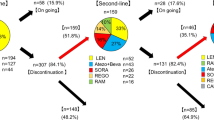Abstract
As part of supportive therapy, prophylaxis with tiopronin for injection (TI) against common hepatotoxicity complications has often been used. However, methods to prevent hepatotoxicity have not been established. Therefore, our study was aimed to find out the relationship between the periods of TI prophylaxis and post-treatment hepatotoxicity, and evaluated the value of prolonging the duration of TI administration in preventing hepatotoxicity. Hepatotoxicity was detected through liver transaminases, bilirubin, alkaline phosphatase, and clinical features of liver insufficiency. Multivariable logistic regressions were conducted to examine the association of the periods of TI prophylaxis and post-treatment hepatotoxicity. Between January 2022 and March 2023, a total of 452 patients with gynecological cancer were enrolled in the study, of which 93 (20.58%) participants were post-treatment hepatotoxicity positive. TI with different prevention days were no significant difference among participants with or without post-treatment hepatotoxicity in crude model (P > 0.05). The P-value, the odds ratios (OR) and 95% confidence intervals (CI) of participants with TI prophylaxis for 1 day for post-treatment hepatotoxicity were 0.040, 3.534 (1.061–11.765) in fully adjusted model. Past history of hepatotoxicity is a confounding variable, and there was no significant difference for post-treatment hepatotoxicity when stratified by past history of hepatotoxicity (P > 0.05). The study indicate that the periods of TI prophylaxis is not associated with post-treatment hepatotoxicity, suggesting that prolonged the periods of TI prophylaxis might be an invalid method for the prevention of post-treatment hepatotoxicity.
Similar content being viewed by others
Introduction
Gynecological cancer patients are a group of cancers involving the female reproductive system, that includes cancers of the ovary, cervix, uterine corpus, fallopian tube, vagina and vulva1. In 2018, the combined mortality for cervical, uterine and ovarian cancers reached 14%. In 2022, Cancers of the cervix and ovary account, respectively, for the 7th and 9th tumor mortality rate among women in China2,3. Current gynecological cancer treatment methods mainly include surgery, chemotherapy, radiotherapy, and the combined chemo-radiation4,5,6. However, prolonged chemotherapy often leads to varying degrees of liver toxicity and relatively specific pathological changes, resulting in decreased liver tolerance and discontinuation of chemotherapy7,8,9. Although there is no consensus on their effectiveness against drug-induced hepatotoxicity, hepatoprotective drugs have often been used empirically in patients with drug-induced hepatotoxicity10.
Tiopronin, is a low-molecular-weight thiol derivative of glycine that has been used to treat a variety of conditions. Its –SH moiety can reduce disulfide linkages between oxidized biothiols, like glutathione disulfide, restoring them to their native state. In addition, tiopronin is regarded as an effective chelator of heavy metals such as mercury and copper. Because of these significant antioxidant properties, tiopronin has been used to protect against chemotherapy-induced nephrotoxicity and hepatotoxicity11. Tiopronin has also proved effective in perioperative liver function protection. Its preventive role in chemotherapy induced hepatotoxicity is important for cancers12.
Some clinicians believe that the duration of TI prophylaxis is associated with post-treatment hepatotoxicity, and the duration of TI prophylaxis should be prolonged when the high hepatotoxicity drugs were used, and/or the duration of chemotherapy drugs is longer, and/or the Past history of hepatotoxicity positive. Thus, we conducted a study in patients with gynecological cancer to explore the association between the periods of TI prophylaxis and post-treatment hepatotoxicity.
Results
General characteristics of subjects
A total of 452 individuals were included in this study; 452 (100%) were females, with an average age of 57.00 ± 17.00 years. The clinical and demographic characteristics are shown in Table 1. The proportion of recurrent hepatotoxicity in patients with past history of hepatotoxicity was higher in the post-treatment hepatotoxicity (+) group than in the post-treatment hepatotoxicity (−) group (P < 0.05). In addition, combinations of chemotherapeutic drugs and duration of chemotherapy drugs were significant difference in participants with or without post-treatment hepatotoxicity (P < 0.05). In contrast, TI with different prevention days were no significant difference among participants with or without post-treatment hepatotoxicity (P > 0.05).
Association between the periods of TI prophylaxis and post-treatment hepatotoxicity
Multivariable logistic regressions were conducted to examine the association of the periods of TI prophylaxis and post-treatment hepatotoxicity. As shown in Table 2, the P-value, the OR and 95% CI of participants with TI prophylaxis for 1 day for post-treatment hepatotoxicity were 0.254, 1.794 (0.657–4.899) in the crude Model. After further adjusting for duration of chemotherapy drugs, combinations of chemotherapeutic drugs, and past history of hepatotoxicity, the P-value, the OR and 95% CI of participants with TI prophylaxis for 1 day for post-treatment hepatotoxicity were 0.040, 3.534 (1.061–11.765) (Model 3).
Analysis of confounding variables
Multivariate logistic regression was used to analyze the confounding variables for post-treatment hepatotoxicity. As is shown in Table 3, past history of hepatotoxicity is a confounding variable.
Sensitivity analysis in previous hepatotoxicity of patients groups
As shown in Table 4, stratified analyses were performed to explore the association between the periods of TI prophylaxis and post-treatment hepatotoxicity. Stratified analyses were made for past history of hepatotoxicity. Participants were divided into two groups according to past history of hepatotoxicity: past history of hepatotoxicity (+) group and past history of hepatotoxicity (−) group. After adjusting for duration of chemotherapy drugs and combinations of chemotherapeutic drugs, there was no significant difference for post-treatment hepatotoxicity when stratified by past history of hepatotoxicity (P > 0.05).
Discussion
In this study, the definitions of hepatotoxicity are as follows, hepatotoxicity is injury to the liver associated with impaired liver function (elevated bilirubin) cause by a foreign substance13. Based on the elevation of liver transaminases, bilirubin, alkaline phosphatase, and clinical features of liver insufficiency, the World Health Organization has developed liver toxicity criteria that classifies hepatic damage as one of five grades (0–4)14.
TI approved for fatty liver and drug-induced liver injury in China. One publication reported that tiopronin may act as a glutathione peroxidase (GPX) inhibitor to selectively kill multi-drug resistant (MDR) cancer cells. Another reported that MDR overexpressing cancer cells were more sensitive to tiopronin than native cells. Thus, tiopronin could find an additional indication in cancer therapy15. Tiopronin is often used as an empirical prophylactic drug in the treatment of gynecological cancer patients. Nevertheless, for all we know, few studies have reported the usage and dosage of TI prophylaxis to prevent hepatotoxicity. Some clinicians empirically believe that prolonged the periods of TI prophylaxis is more effective in preventing hepatotoxicity. From this perspective, it has valuable to study the relationship between the periods of TI prophylaxis and post-treatment hepatotoxicity.
Many risk factors are associated with hepatotoxicity. In particular, several studies have reported a positive association between viral hepatitis and hepatotoxicity16,17, therefore we excluded those with viral hepatitis to eliminate the possibility of hepatotoxicity occurring other than elevated liver enzymes. Chemotherapy and radiotherapy are the two main approaches for cancer treatment besides surgery. The combination of chemotherapy and radiotherapy towards more efficient drug delivery18. But both treatments have the potential to cause liver toxicity in patients. Some chemotherapeutic drugs have been proven to be Hepatotoxic19,20,21,22,23,24,25. Low hepatotoxicity has been reported in children after irradiation of various abdominal and thoracic tumors26. The combination of radiotherapy and chemotherapy may increase the risk of liver toxicity. In this research, patients were included a combination of chemotherapy and radiotherapy, and the patient experienced low hepatotoxicity after treatment: elevated liver transaminase < 3ULN (Upper limit of normal), and elevated bilirubin < 2.5ULN. Thus, instead of using the criteria for drug hepatotoxicity, we used the criteria for hepatotoxicity established by the World Health Organization. Hepatotoxicity was not reported among the adverse reactions of bevacizumab27,28, therefore, bevacizumab is not necessary for grouping chemotherapy drugs. CTLA-4 and PD-1 immune checkpoint inhibitors can cause immune-related hepatotoxicity24,25, however, the mechanism of immune-related hepatotoxicity is different from that of chemotherapeutic drugs, so immune checkpoint inhibitors are included in other chemotherapeutic drug groups.
The present study has some limitations. First, this study was a retrospective study, and most of the hepatotoxicity in patients after treatment was grade 1. Therefore, hepatotoxicity was not graded. Second, due to the limited number of applicable patients, we only selected patients with gynecological cancer, patients with other cancers such as breast cancer were not included in this study. Third, TI has been used prophylactically in clinical practice for patients treated to interrupt treatment due to concerns about hepatotoxicity. This fact makes it a lack of data studies on the relationship between hepatotoxicity prevention with and without TI. Despite the above limitations, we believe this study has valuable implications for clinical practice.
In conclusion. The study indicate that the periods of TI prophylaxis is not associated with post-treatment hepatotoxicity, suggesting that prolonged the periods of TI prophylaxis might be an invalid method for the prevention of post-treatment hepatotoxicity.
Methods
Study the population and the treatment
This is a retrospective study. Between January 2022 and March 2023, a total of 3144 patients were assessed for eligibility at the Anyang Tumor Hospital. Of these, 452 patients with gynecological cancer were enrolled in the study and subsequently analyzed. The criteria for enrollment in this study were as follows: (1) The patients had no history of alcoholism, smoking or hepatitis. (2) The liver function test of the patient was normal before treatment, and there were no clinical symptoms of liver insufficiency. (3) Patients were treated with chemotherapy or combined chemo-radiation. TI was given prophylactically (0.2 g/day) when patients were treated with chemotherapy or concurrent chemoradiotherapy.
Data sources
The patients’ data was collected and sorted from our hospital’s electronic database, which contains prior medical records and postoperative follow-up information. Data obtained from medical records included tumor type, treatment method, patient's underlying disease, combinations of chemotherapeutic drugs, duration of chemotherapy drugs, Patient prognosis, duration of TI prophylactic medication, biochemical parameter values and clinical characteristics of patients' alanine aminotransferase (ALT), aspartate aminotransferase (AST), alkaline phosphatase (ALP) and total bilirubin (TBIL).
Statistical analysis
Categorical variables were described as percentage (%) and compared by Chi-square tests. The Shapiro–Wilk W test was used for continuous variables. Non-normal distributed continuous variables were described as the medians ± quartiles and compared with the Mann–Whitney U test. the multivariable logistic regression models were used to calculate the odds ratio (OR) and 95% confidence interval (95% CI) for post-treatment hepatotoxicity. Adjustments were made for 3 variables (duration of chemotherapy drugs, combinations of chemotherapeutic drugs, and past history of hepatotoxicity), and past history of hepatotoxicity was identified as potential confounders of the risk factors for post-treatment hepatotoxicity. Sensitivity analyses were used to estimate the association between the periods of TI prophylaxis and post-treatment hepatotoxicity, stratified by past history of hepatotoxicity. Statistical analyses were performed using SPSS software (version 20.0, SPSS Inc, Chicago, IL, USA). All statistical tests were 2-sided, and significance levels were 0.05.
Ethical approval
The protocol for this research project has been approved by a suitably constituted Ethics Committee of the institution, and it conforms to the provisions of the Declaration of Helsinki. Committee of Anyang Tumor Hospital, Approval No. 2023WZ21K01.
Informed consent
This study is a retrospective study, using medical records obtained from previous clinical treatment, and the data does not include information that can be traced to the subjects' privacy, such as medical record number, ID number, address, and contact information. The exemption from informed consent will not adversely affect the rights and health of the subject. Therefore, informed consent was exempted by the Ethics Committee of Anyang Tumor Hospital.
Data availability
The datasets supporting the conclusions of the current study are available in the Affiliated Anyang Tumor Hospital of Henan University of Science and Technology, and the datasets will be shared with the corresponding author upon reasonable request.
Abbreviations
- TI:
-
Tiopronin for injection
- GPX:
-
Glutathione peroxidase
- MDR:
-
Multi-drug resistant
- ALT:
-
Alanine aminotransferase
- AST:
-
Aspartate aminotransferase
- ALP:
-
Alkaline phosphatase
- TBIL:
-
Total bilirubin
- ULN:
-
Upper limit of normal
- CTLA-4:
-
Cytotoxic T lymphocyte associated antigen-4
- PD-1:
-
Programmed death-1
References
Bibi, S., Ashfaq, S. & Laghari, N. A. A heartrending burden of gynaecological cancers in advance stage at nuclear institute of medicine and radiotherapy Jamshoro Sindh. Pak. J. Med. Sci. 32, 120–124 (2016).
Bray, F. et al. Global cancer statistics 2018: GLOBOCAN estimates of incidence and mortality worldwide for 36 cancers in 185 countries. CA Cancer J. Clin. 68, 394–424 (2018).
Xia, C. et al. Cancer statistics in China and United States, 2022: Profiles, trends, and determinants. Chin. Med. J. (Engl.) 135, 584–590 (2022).
Yang, C. et al. Immunotherapy for ovarian cancer: Adjuvant, combination, and neoadjuvant. Front. Immunol. 11, 577869 (2020).
Small, W. Jr. et al. Cervical cancer: A global health crisis. Cancer 123, 2404–2412 (2017).
Koskas, M., Amant, F., Mirza, M. R. & Creutzberg, C. L. Cancer of the corpus uteri: 2021 update. Int. J. Gynaecol. Obstet. 155(Suppl 1), 45–60 (2021).
Raúl, A. et al. EASL clinical practice guidelines: Drug-induced liver injury. J. Hepatol. 70, 1222–1261 (2019).
Chalasani, N. P. et al. ACG clinical guideline: Diagnosis and management of idiosyncratic drug-induced liver injury. Am. J. Gastroenterol. 116, 878–898 (2021).
Choti, M. A. Chemotherapy-associated hepatotoxicity: Do we need to be concerned?. Ann. Surg. Oncol. 16, 2391–2394 (2009).
Saito, Z. et al. Effectiveness of hepatoprotective drugs for anti-tuberculosis drug-induced hepatotoxicity: A retrospective analysis. BMC Infect. Dis. 16, 668 (2016).
Beltz, J., Chernatynskaya, A., Pfaff, A. & Ercal, N. Protective effects of tiopronin on oxidatively challenged human lung carcinoma cells (A549). Free Radic. Res. 54, 319–329 (2020).
Wang, J. Q. et al. Protective effects of tiopronin against high fat diet-induced non-alcoholic steatohepatitis in rats. Acta Pharmacol. Sin. 33, 791–797 (2012).
Ricart, A. D. Drug-induced liver injury in oncology. Ann. Oncol. 28, 2013–2020 (2017).
Floyd, J., Mirza, I., Sachs, B. & Perry, M. C. Hepatotoxicity of chemotherapy. Semin. Oncol. 33, 50–67 (2006).
Behnisch-Cornwell, S., Laubenstein, G. & Bednarski, P. J. Studies of the inhibitory activities of tiopronin and mercaptosuccinic acid on glutathione peroxidase and their cytotoxic and antioxidant properties. Pharmazie 74, 536–542 (2019).
Zhang, Y. Y. & Hu, K. Q. Rethinking the pathogenesis of hepatitis B virus (HBV) infection. J. Med. Virol. 87, 1989–1999 (2015).
Suhail, M. et al. Potential mechanisms of hepatitis B virus induced liver injury. World J. Gastroenterol. 20, 12462–12472 (2014).
Cao, W., Gu, Y., Meineck, M. & Xu, H. The combination of chemotherapy and radiotherapy towards more efficient drug delivery. Chem. Asian J. 9, 48–57 (2014).
Da Costa Junior, L. C., De Castro, C. L., Freitas-Alves, D. R., Vianna-Jorge, R. & Santos, P. C. J. L. ABCB1 and ERCC1 gene polymorphisms are associated with nephro- and hepatotoxicity to carboplatin/paclitaxel-based chemotherapy in patients with gynecologic cancers. Eur. J. Clin. Pharmacol. 76, 1401–1408 (2020).
Tao, G. et al. Potential role of drug metabolizing enzymes in chemotherapy-induced gastrointestinal toxicity and hepatotoxicity. Expert Opin. Drug Metab. Toxicol. 16, 1109–1124 (2020).
Han, G. et al. Clinical efficacy and safety of paclitaxel liposomes as first-line chemotherapy in advanced gastric cancer. Future Oncol. 15, 1617–1627 (2019).
Guarin, J. R., Fatherree, J. P. & Oudin, M. J. Chemotherapy treatment induces pro-invasive changes in liver ECM composition. Matrix Biol. 112, 20–38 (2022).
Bahirwani, R. & Reddy, K. R. Drug-induced liver injury due to cancer chemotherapeutic agents. Semin. Liver Dis. 34, 162–171 (2014).
Jennings, J. J., Mandaliya, R., Nakshabandi, A. & Lewis, J. H. Hepatotoxicity induced by immune checkpoint inhibitors: A comprehensive review including current and alternative management strategies. Expert Opin. Drug Metab. Toxicol. 15, 231–244 (2019).
Remash, D. et al. Immune checkpoint inhibitor-related hepatotoxicity: A review. World J. Gastroenterol. 27, 5376–5391 (2021).
Rösler, P. et al. Hepatotoxicity after liver irradiation in children and adolescents: Results from the RiSK. Strahlenther Onkol. 191, 413–420 (2015).
Garcia, J. et al. Bevacizumab (Avastin®) in cancer treatment: A review of 15 years of clinical experience and future outlook. Cancer Treat. Rev. 86, 102017 (2020).
Syed, Y. Y. SB8: A bevacizumab biosimilar. Target. Oncol. 15, 787–790 (2020).
Author information
Authors and Affiliations
Contributions
H.Y.Y. designed the study and the manuscript. M.Z.L. and H.Y.Y. made substantial contribution to analysis and interpretation of data. M.X.L., H.W.G, D.L., S.Y. and X.D.H. contributed to the data collection. All authors read and approved the finial manuscript.
Corresponding author
Ethics declarations
Competing interests
The authors declare no competing interests.
Additional information
Publisher's note
Springer Nature remains neutral with regard to jurisdictional claims in published maps and institutional affiliations.
Rights and permissions
Open Access This article is licensed under a Creative Commons Attribution 4.0 International License, which permits use, sharing, adaptation, distribution and reproduction in any medium or format, as long as you give appropriate credit to the original author(s) and the source, provide a link to the Creative Commons licence, and indicate if changes were made. The images or other third party material in this article are included in the article's Creative Commons licence, unless indicated otherwise in a credit line to the material. If material is not included in the article's Creative Commons licence and your intended use is not permitted by statutory regulation or exceeds the permitted use, you will need to obtain permission directly from the copyright holder. To view a copy of this licence, visit http://creativecommons.org/licenses/by/4.0/.
About this article
Cite this article
Yang, H., Lin, M., Liu, M. et al. Evaluate the value of prolonging the duration of tiopronin for injection administration in preventing hepatotoxicity. Sci Rep 14, 3674 (2024). https://doi.org/10.1038/s41598-024-54314-3
Received:
Accepted:
Published:
DOI: https://doi.org/10.1038/s41598-024-54314-3
Keywords
Comments
By submitting a comment you agree to abide by our Terms and Community Guidelines. If you find something abusive or that does not comply with our terms or guidelines please flag it as inappropriate.



